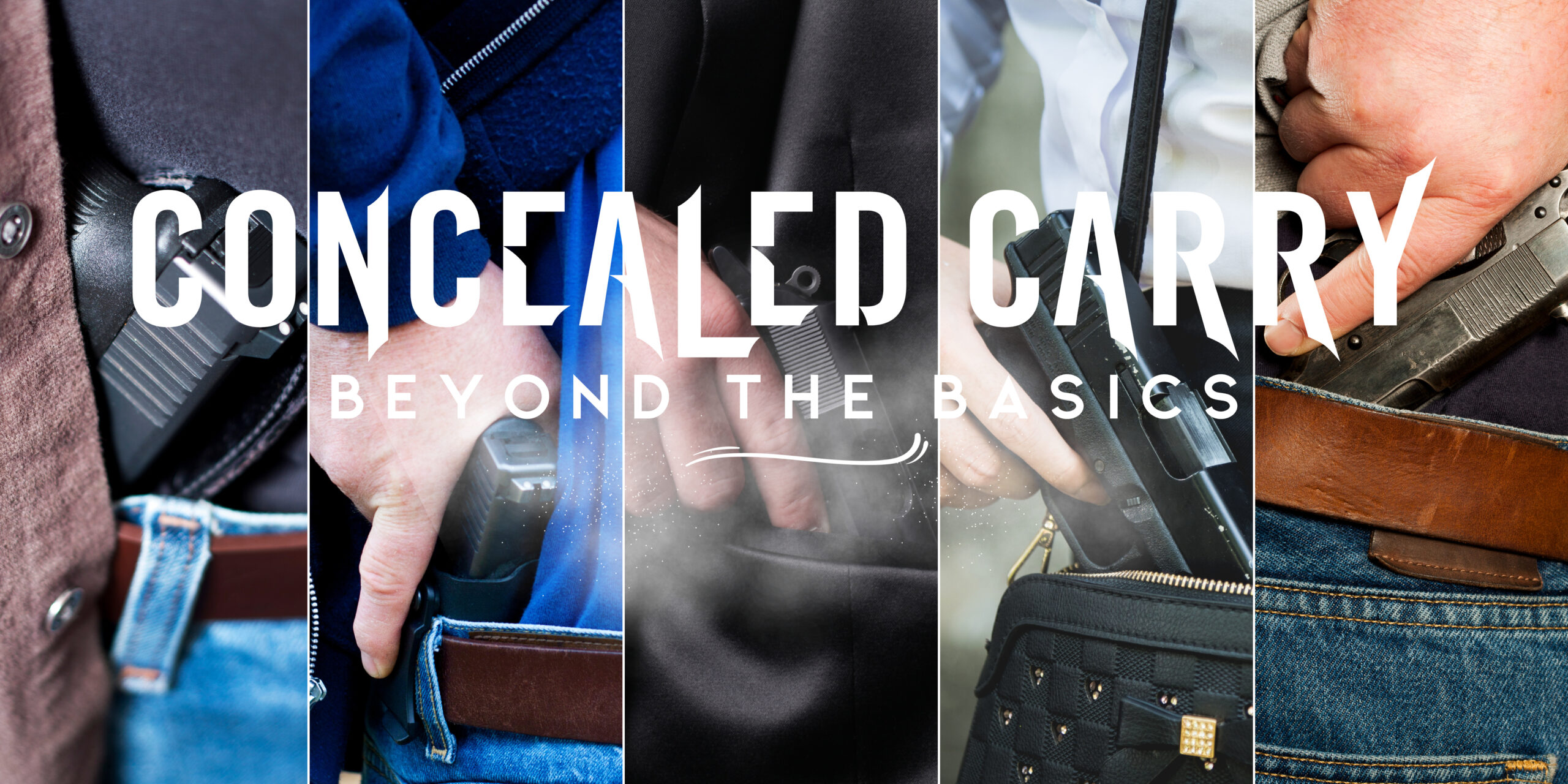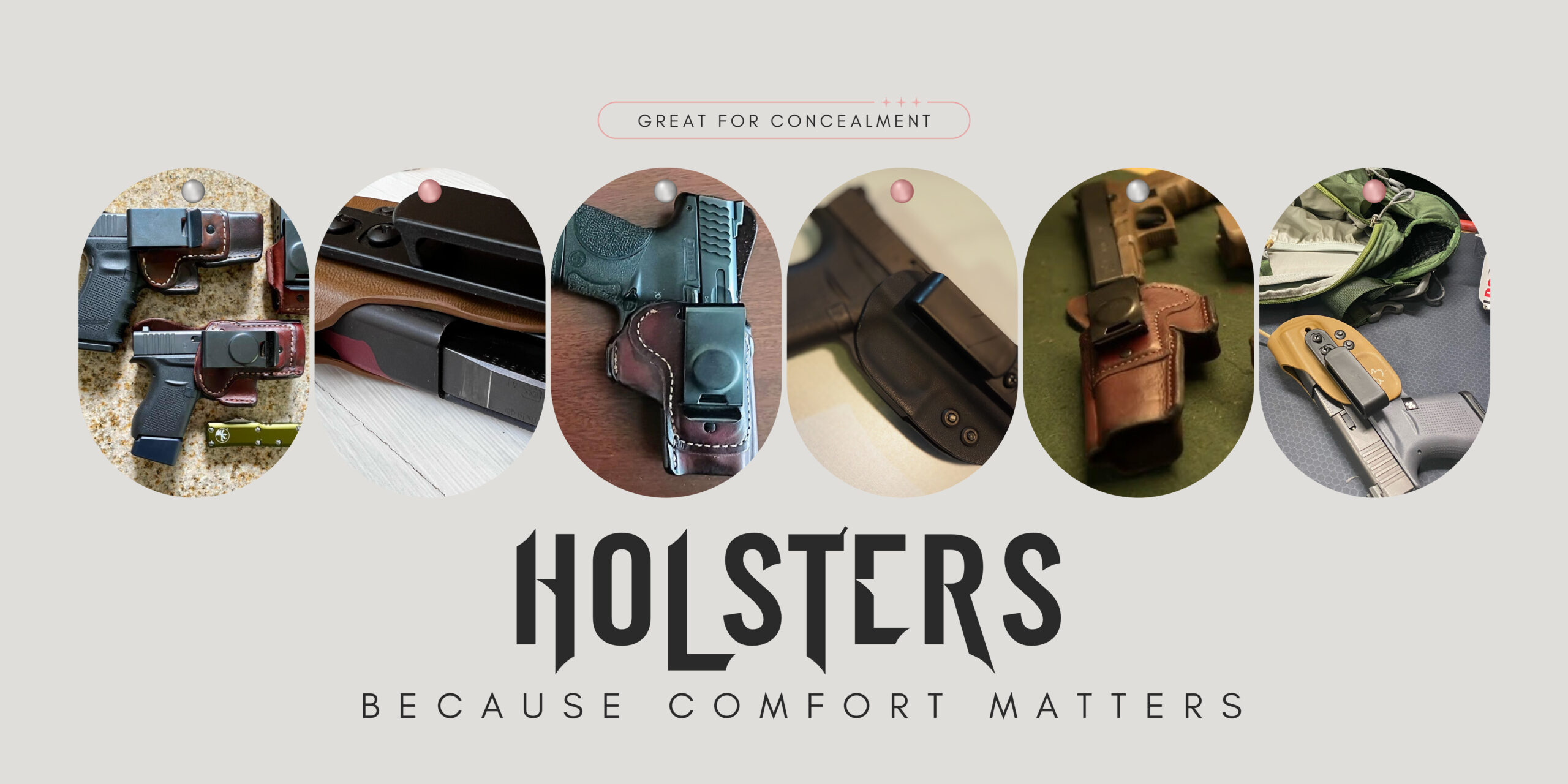Last week on the Blog we briefly touched base on Tips for Staying Safe and Confident while concealed carry. Join me as we break these tips down even further.
Choosing the Right Firearm:
Selecting the perfect concealed carry firearm is a critical decision that can significantly impact your safety and comfort. To ensure you make the right choice, consider the following factors:
- Caliber: The caliber of your firearm plays a crucial role in its stopping power and recoil. It’s essential to strike a balance between effectiveness and controllability. .380 ACP, 9mm, .40 S&W, and .45 ACP are popular choices for concealed carry. Remember that the right caliber for you might not be the same for someone else.
- Size: Concealed carry firearms come in various sizes, from subcompacts to full-size handguns. Smaller guns are easier to conceal, but they may have fewer rounds in the magazine and might be more challenging to shoot accurately. Consider how well you can handle the firearm’s size and weight while maintaining comfort.
- Reliability: Reliability is non-negotiable when it comes to concealed carry. You need a firearm that fires when you pull the trigger, every time. Research and reviews can help you determine the reliability of a specific make and model.
- Ergonomics: The ergonomics of a firearm, including grip size and trigger reach, are personal preferences. Choose a firearm that feels comfortable and natural in your hand, as this can improve your accuracy and control.
Remember, there is no one-size-fits-all answer when it comes to selecting the right concealed carry firearm. It’s essential to visit a local gun store, handle different models, and even rent them at a range to find the one that suits you best.
Holster Selection:
The choice of holster is just as critical as selecting the right firearm. Your holster affects both your comfort and accessibility. Let’s explore some common types of holsters:
- Inside-the-Waistband (IWB): IWB holsters are worn inside the pants, offering excellent concealment. They’re popular for their low profile but may require adjustments to your clothing choices. Choose an IWB holster that positions the firearm securely and comfortably on your body. This is why we created the Condom Holster! For the perfect, most comfortable IWB carry.
- Outside-the-Waistband (OWB): OWB holsters are worn on the outside of your clothing and are often preferred for open carry. While they provide easier access, they are less discreet than IWB holsters. Ensure your OWB holster securely retains the firearm while allowing for a smooth draw.
- Appendix Carry: This IWB position places the firearm in the front of your body, usually around the appendix area. It offers quick access but requires proper training to ensure safe handling. The Deep Concealed Holster by SOB Tactical is an excellent go-to!
- Pocket Holsters: Designed for smaller firearms, pocket holsters fit in your pocket, offering excellent concealment. They prevent printing and keep the firearm in an upright position for easy access.
When selecting a holster, consider factors such as comfort, concealment, and accessibility. It’s also essential to practice drawing and holstering your firearm safely with your chosen holster to build muscle memory.
Training and Skill Development:
Owning a concealed carry firearm is not enough; you must invest in training and skill development. Consider the following aspects:
- Firearm Safety: Begin with a comprehensive understanding of firearm safety rules. Always treat every firearm as if it’s loaded, keep it pointed in a safe direction, keep your finger off the trigger until you’re ready to shoot, and know your target and what’s beyond it.
- Marksmanship: Regular range practice is crucial to improve your marksmanship. Focus on fundamentals like sight alignment, trigger control, and breath control to enhance your accuracy.
- Situational Awareness: Being aware of your surroundings is a critical component of personal defense. Practice situational awareness by scanning your environment, identifying potential threats, and maintaining a proactive mindset.
- Decision-Making Drills: Simulate real-life scenarios during your training, so you’re prepared to make quick and effective decisions in high-stress situations.
- Dry Fire Practice: Dry fire practice involves safely handling an unloaded firearm to improve trigger control, sight alignment, and drawing skills. Incorporate this into your regular training routine.
- Professional Training: Consider enrolling in concealed carry courses and seeking instruction from certified firearms trainers. These experts can provide valuable guidance and feedback.
Concealment Clothing:
Dressing appropriately is crucial for effective concealed carry. It’s essential to strike a balance between style, comfort, and discreet carry. Here are some clothing tips:
- Cover Garments: Choose loose-fitting shirts, jackets, or vests that help conceal your firearm without printing. Darker and patterned clothing can also aid in concealing the outline of your gun.
- Belt Selection: A sturdy, purpose-built gun belt is essential to support the weight of your firearm and holster. It prevents sagging or shifting, ensuring your firearm remains secure and concealed.
- Appendix Carry Clothing: If you prefer appendix carry, opt for pants with a slightly larger waistband to accommodate your holster comfortably.
- Footwear: Comfortable and supportive footwear can assist in maneuvering and maintaining stability in self-defense situations.
Legal Considerations: Understanding the legal aspects of concealed carry is paramount. Laws and regulations can vary significantly between states and even within regions. Here are some key considerations:
- Permit Requirements: Ensure you’re aware of your state’s concealed carry permit requirements. Some states may be “shall-issue,” meaning they must issue a permit if you meet the legal criteria, while others may be “may-issue,” allowing discretion.
- Reciprocity: If you plan to travel, research which states honor your concealed carry permit through reciprocity agreements.
- Duty to Retreat: Some states have “stand your ground” laws, while others have a “duty to retreat.” Know the self-defense laws specific to your jurisdiction.
- Prohibited Areas: Familiarize yourself with locations where concealed carry is prohibited, such as schools, government buildings, and private property with “no guns” signs.
- Firearm Transport: Understand the legal requirements for transporting your firearm in a vehicle. In some states, it must be unloaded and stored separately from the ammunition.
Always consult local and state laws or seek advice from legal professionals to ensure you’re compliant with concealed carry regulations in your area.
Mental Preparation:
Preparing mentally for concealed carry is just as important as physical training. Your mindset and decision-making abilities are crucial in high-stress situations. Here are some strategies for mental preparation:
- Situational Awareness: Develop the habit of scanning your environment and identifying potential threats. Be aware of your surroundings and the people around you.
- De-escalation Techniques: Learn verbal de-escalation techniques to defuse potentially dangerous situations before they escalate.
- Mindset Training: Consider mental preparedness and mindset training to help you stay calm and focused during a crisis. Visualization and scenario-based training can be valuable tools.
- Legal and Ethical Considerations: Understand the legal and ethical implications of using deadly force for self-defense. Seek professional guidance on these matters.
- Practice Under Stress: Incorporate stress-inducing scenarios into your training. This can help you adapt to high-pressure situations.
Conclusion: Concealed carry is a significant responsibility that requires careful planning, training, and commitment. By following the tips and insights in this week’s blog post, you’ll be better equipped to navigate the world of concealed carry with confidence and safety in mind. Remember, it’s not just about carrying a firearm; it’s about carrying a responsibility to protect yourself and those around you while upholding the highest standards of safety, legality, and preparedness. Stay tuned for more valuable information and training insights from SOB Tactical, your trusted source for concealed carry expertise.


